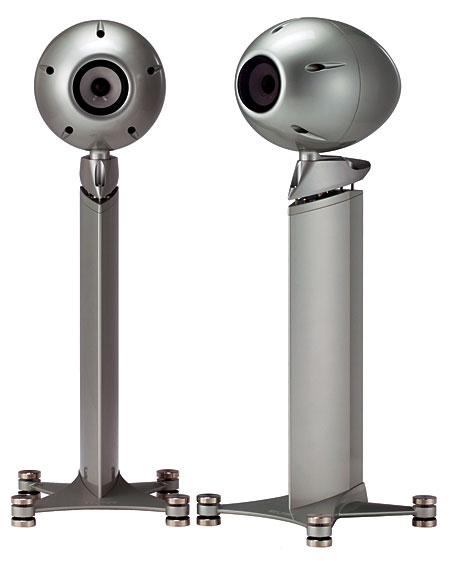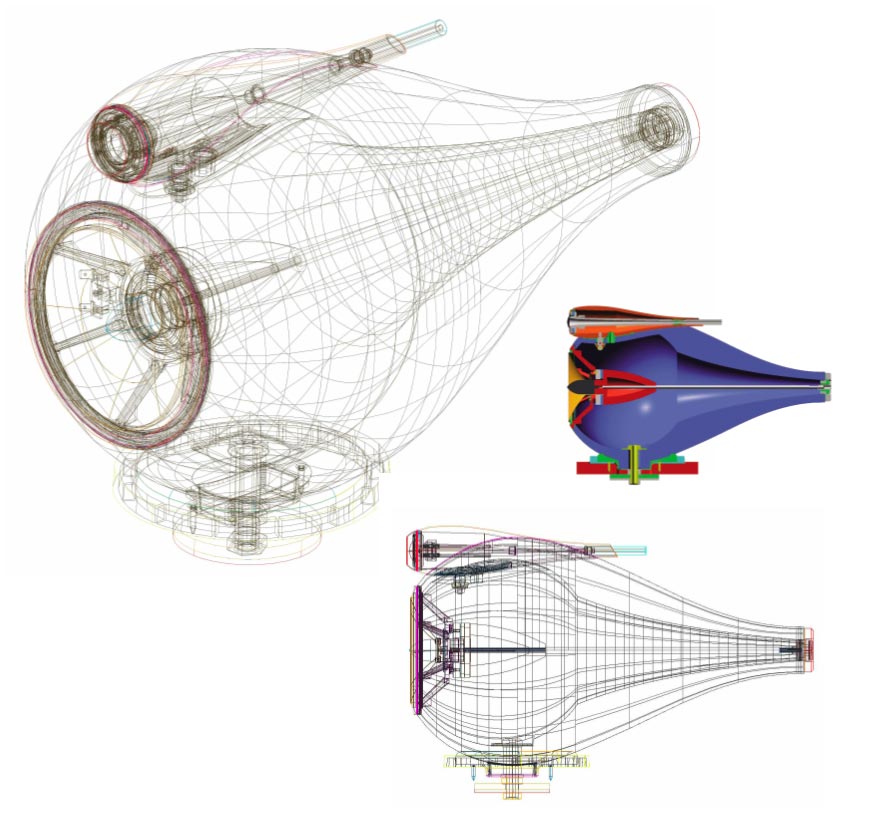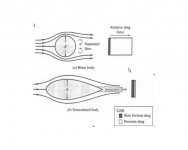In my original posting regarding curved speaker enclosures http://www.diyaudio.com/forums/showthread.php?postid=1719488#post1719488 this statement regarding spherical speakers was made.
"A spherical INTERNAL shape just creates one single honking great resonance. Worst possible shape unless the driver used doesn't operate at the resonance's frequency (or, presumably, have any harmonics there."
But from an EXTERNAL point of view, http://www.usenclosure.com/WELCOME TO US ENCLOSURE COMPANY/index.htm (read the bit about diffraction effects caused by loudspeaker enclosures) a spherical speaker is perhaps the better shape.
If the above is correct, it doesn't seem to me to be particularly difficult, to change the the internal shape of a sphere by having say, having a flat floor or/both wall etc to break up the spherical shape if this would solve the above problem.
Not knowing too much about these things technically, what would be the best internal shape to go for to get the best of both worlds?
For me, making my own spherical speaker enclosures out of GRP (fibreglass and resin) would be fairly easy, as I have had some experience with GRP products.
Usenclosure.com don't seem to be in business any longer and I am trying to get some information of the best (from an audio point of view) polyurethane foam, Styrofoam etc etc or something else to use in the sandwich construction. Any ideas anybody?
These people make polystyrene balls http://www.grahamsweet.com/balls/moulded-balls-price.php but don't know how good polystyrene is as a sound deadening sandwich filler. One would have to use epoxy resin with polystyrene as other resins tend to dissolve it.
"A spherical INTERNAL shape just creates one single honking great resonance. Worst possible shape unless the driver used doesn't operate at the resonance's frequency (or, presumably, have any harmonics there."
But from an EXTERNAL point of view, http://www.usenclosure.com/WELCOME TO US ENCLOSURE COMPANY/index.htm (read the bit about diffraction effects caused by loudspeaker enclosures) a spherical speaker is perhaps the better shape.
If the above is correct, it doesn't seem to me to be particularly difficult, to change the the internal shape of a sphere by having say, having a flat floor or/both wall etc to break up the spherical shape if this would solve the above problem.
Not knowing too much about these things technically, what would be the best internal shape to go for to get the best of both worlds?
For me, making my own spherical speaker enclosures out of GRP (fibreglass and resin) would be fairly easy, as I have had some experience with GRP products.
Usenclosure.com don't seem to be in business any longer and I am trying to get some information of the best (from an audio point of view) polyurethane foam, Styrofoam etc etc or something else to use in the sandwich construction. Any ideas anybody?
These people make polystyrene balls http://www.grahamsweet.com/balls/moulded-balls-price.php but don't know how good polystyrene is as a sound deadening sandwich filler. One would have to use epoxy resin with polystyrene as other resins tend to dissolve it.
The first statement is incorrect.
ANY internal shape will have one single resonance frequency. That's why it's called the box resonance frequency.
BOTH from an internal and an external POW a spherical shape is ideal. Internally because there's no parallel sides to create standing waves (above the resonace frequency, at and below that frequency all sides are parallel to eachother). Externally because of theorically zero diffraction.
From a structural POW the spherical shape makes cabinet vibrations impossible under the resonance frequency, so dampening should only be focused on higher frequency making bracing redundant.
ANY internal shape will have one single resonance frequency. That's why it's called the box resonance frequency.
BOTH from an internal and an external POW a spherical shape is ideal. Internally because there's no parallel sides to create standing waves (above the resonace frequency, at and below that frequency all sides are parallel to eachother). Externally because of theorically zero diffraction.
From a structural POW the spherical shape makes cabinet vibrations impossible under the resonance frequency, so dampening should only be focused on higher frequency making bracing redundant.
"A spherical INTERNAL shape just creates one single honking great resonance. Worst possible shape unless the driver used doesn't operate at the resonance's frequency (or, presumably, have any harmonics there."
FWIW: There was a study that contended that an Ovoid - without parallel walls and no predominate axis is the best - from the standpoint of minimizing internal reflection...
Obviously a shape with 1 predominate dimension ( the diameter ) would have a tendency to resonate based upon that dimension. As would a pipe/ tube or cylinder.
But appropriate internal bracing and sound deadening can effectively minimize resonance.
One of the things that gets overlooked, is that almost every speaker builder put bracing and some form of acoustic dampening in the cab anyway.
A lot is made of the ratio of dimensions in a 6 sided box, As a precaution I would not make a cab such that the dimensions were even multiples.
A cab made out of the wrong material ( or undamped ) will ring regardless of shape.
IMO Internal shape is not as significant and bracing and sound deadening ( and I am a fan of external curves for the MF/HF diffraction reduction )
For a given internal volume all shapes will have the exact same lowest modal frequency AND will have the same modal density as frequency goes up. The exact locations of the modes will differ with shape, but on the average all shapes will have the same number. Hence there isn't much advantage at all to internal shape. They should all be damped internally.
Structurally a sphere has the largest advantage since it has the least surface area for a given intenrnal volume - hence it will have the least structural resonances in any given frequency band.
But a sphere is not the "perfect shape for minimum diffraction. That would be an oblate spheroid. There is a slope change on the enclosure surface at the edge of the driver for a sphere. There isn't one with the proper oblate spheroid. But this difference is not huge and the sphere is far easier to make. Hence it is a "good" choice. But any cabinet with sufficiently rounded edges will work nearly as well as the sphere, but is a lot easier to make. Cabinets with sharp edges - as most are - is the worst case situation.
Structurally a sphere has the largest advantage since it has the least surface area for a given intenrnal volume - hence it will have the least structural resonances in any given frequency band.
But a sphere is not the "perfect shape for minimum diffraction. That would be an oblate spheroid. There is a slope change on the enclosure surface at the edge of the driver for a sphere. There isn't one with the proper oblate spheroid. But this difference is not huge and the sphere is far easier to make. Hence it is a "good" choice. But any cabinet with sufficiently rounded edges will work nearly as well as the sphere, but is a lot easier to make. Cabinets with sharp edges - as most are - is the worst case situation.
HK26147 said:After discussion with Geddes , I realized there is no need to make a giant egg.
( Thanks )
When looking at the outside it would make sense
I would suggest that, given the large amount of serious research that has been put into it, the shape of the B&W mid enclosure (a variation also seen in the Fujitsu Ten line) is close to the perfect shape from the outside. These avoid the issue of the inside of a sphere where 3 of the big modes are all at the same frequency.

The F10 speakers approximate an ellipsoid (ala oblate spheroid), the B&W a bit different. The Mach speakers used an egg shape for the mid+tweeter & where highly reguarded from a diffraction POV,
dave

The F10 speakers approximate an ellipsoid (ala oblate spheroid), the B&W a bit different. The Mach speakers used an egg shape for the mid+tweeter & where highly reguarded from a diffraction POV,
dave
gedlee said:An ellipsoid is not an oblate spheriod.
Yes, that is true, but an oblate spheroid is an ellipsoid "An oblate spheroid is a rotationally symmetric ellipsoid" ie a=b>c.
dave
gedlee said:If B&W were actually concerned with diffraction they would not have put those screw holes on the front. They obviuosly use this shape for appearances.
What screw holes?
An externally hosted image should be here but it was not working when we last tested it.
dave
planet10 said:
Yes, that is true, but an oblate spheroid is an ellipsoid "An oblate spheroid is a rotationally symmetric ellipsoid" ie a=b>c.
dave
Incorrect. An oblate spheroid is an ellipse rotated about its semi-minor axis. A prolate spheroid is an ellipse rotated about it semi-major axis. An elipsoid has no axis of symmetry.
gedlee said:
Incorrect. An oblate spheroid is an ellipse rotated about its semi-minor axis. A prolate spheroid is an ellipse rotated about it semi-major axis. An elipsoid has no axis of symmetry.
An oblate spheroid is a subset of ellipsoids was the point i was trying to make.
I did do a typo, should have been a=b>c
http://en.wikipedia.org/wiki/Oblate
http://en.wikipedia.org/wiki/Ellipsoid
The best shape for diffraction has an ellipsoid on the front, and a cone-like shape on the back, like the B&W enclosure linked above (a spherical ellipsoid)
You see this same shape in high efficiency carsm bicycle helmets, the bulge on the back of a grandPrix racers leathers, submarines...
Which ellipsoid shape to pick is then driven by other considerations in the speaker design.
dave
The best shape for diffraction has an ellipsoid on the front, and a cone-like shape on the back, like the B&W enclosure linked above (a spherical ellipsoid)
[/B]
you mean something like this?
An externally hosted image should be here but it was not working when we last tested it.
Andy G said:you mean something like this?
[/B]
The back is the right kind of thing,,, the front has those sharp corners at the front and the shape towards the back is concave insread of convex.
B&W burned R&D cash we could only dream o to come up with this shape... i'd consider it a good ref for anyone wanting to minimize edge diffraction.

dave
Being very interested in flying I couldn't help noticing the fact that the B&W speaker designs are very similar to low drag streamlined shapes used in the aeronautical world as shown in the illustration below. I wouldn't be surprised if there wasn't a good technical reason for this to be so.
Streamlined body designs are readily available from NASA and others on the Internet,
perhaps we should choose and copy one and use it for a speaker enclosure. Any ideas?
Streamlined body designs are readily available from NASA and others on the Internet,
perhaps we should choose and copy one and use it for a speaker enclosure. Any ideas?
Attachments
Ovoid gevalt!
cirrus18: I had wondered that myself; how much could fluid flow and aerodynamics could be allied to speaker design.
Obvious a box won't fly ( LOL )
Besides R&D money B&W spent a lot on advertising - I and many others received a promo DVD on that model.
IMO: The Fujitsu Ten in black is more appealing, and for their price they could include some plastic screw cap covers ( like used in furniture ).
Set up for mass production of curved shapes undoubtedly involves a lot of capital.
As a poor humble DIY I won't be purchasing the very expensive curved commercial offerings.
I cannot come near the level of sophistication either, But any DIYer can fabricate curved cabs.
I made (2) 8" spheres for less than 50 dollars.
B&W speaker designs are very similar to low drag streamlined shapes used in the aeronautical world
cirrus18: I had wondered that myself; how much could fluid flow and aerodynamics could be allied to speaker design.
Obvious a box won't fly ( LOL )
Besides R&D money B&W spent a lot on advertising - I and many others received a promo DVD on that model.
IMO: The Fujitsu Ten in black is more appealing, and for their price they could include some plastic screw cap covers ( like used in furniture ).
Set up for mass production of curved shapes undoubtedly involves a lot of capital.
As a poor humble DIY I won't be purchasing the very expensive curved commercial offerings.
I cannot come near the level of sophistication either, But any DIYer can fabricate curved cabs.
I made (2) 8" spheres for less than 50 dollars.
Re: Ovoid gevalt!
Little if anything from aerodynamics is applicable to acoustics. One is zero frequency nonlinear Bernouille equation and the other the linear Wave equation valid above DC. The solutions are quite different and don't even overlap in comparable regions.
HK26147 said:
how much could fluid flow and aerodynamics could be allied to speaker design.
Little if anything from aerodynamics is applicable to acoustics. One is zero frequency nonlinear Bernouille equation and the other the linear Wave equation valid above DC. The solutions are quite different and don't even overlap in comparable regions.
Thank you Dr.One is zero frequency nonlinear Bernouille equation and the other the linear Wave equation valid above DC.
How much can be drawn from ripple tank analysis ( in what aspects )?
Re: The wave applets
http://www.falstad.com/mathphysics.html
- Status
- This old topic is closed. If you want to reopen this topic, contact a moderator using the "Report Post" button.
- Home
- Loudspeakers
- Multi-Way
- Spherical speakers and all that jazz
